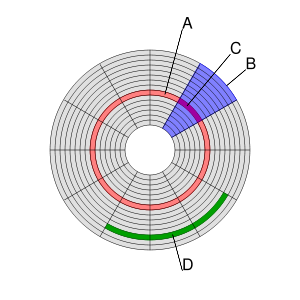.gif)
Cluster (file system)
Encyclopedia

File system
A file system is a means to organize data expected to be retained after a program terminates by providing procedures to store, retrieve and update data, as well as manage the available space on the device which contain it. A file system organizes data in an efficient manner and is tuned to the...
s, a cluster or allocation unit is the unit of disk space allocation for files and directories. To reduce the overhead
Overhead
Overhead may be:* Overhead , the ongoing operating costs of running a business* Engineering overhead, ancillary design features required by a component of a device...
of managing on-disk data structures, the filesystem does not allocate individual disk sector
Disk sector
In computer disk storage, a sector is a subdivision of a track on a magnetic disk or optical disc. Each sector stores a fixed amount of user data. Traditional formatting of these storage media provides space for 512 bytes or 2048 bytes of user-accessible data per sector...
s, but contiguous groups of sectors, called clusters.
On a disk that uses 512-byte sectors, a 512-byte cluster contains one sector, whereas a 4-kibibyte
Kibibyte
The kibibyte is a multiple of the unit byte for quantities of digital information. The binary prefix kibi means 1024; therefore, 1 kibibyte is . The unit symbol for the kibibyte is KiB. The unit was established by the International Electrotechnical Commission in 1999 and has been accepted for use...
(KiB) cluster contains eight sectors.
A cluster is the smallest logical amount of disk space that can be allocated to hold a file. Storing small files on a filesystem with large clusters will therefore waste disk space; such wasted disk space is called slack space. For cluster sizes which are small versus the average file size, the wasted space per file will be statistically about half of the cluster size; for large cluster sizes, the wasted space will become greater. However, a larger cluster size reduces bookkeeping overhead and fragmentation, which may improve reading and writing speed overall. Typical cluster sizes range from 1 sector (512 B) to 128 sectors (64 KiB
Kibibyte
The kibibyte is a multiple of the unit byte for quantities of digital information. The binary prefix kibi means 1024; therefore, 1 kibibyte is . The unit symbol for the kibibyte is KiB. The unit was established by the International Electrotechnical Commission in 1999 and has been accepted for use...
).
A cluster need not be physically contiguous on the disk; it may span more than one track
Track (disk drive)
A disk drive track is a circular path on the surface of a disk or diskette on which information is magnetically recorded and from which recorded information is read....
or, if sector interleaving is used, may even be discontiguous within a track. This should not be confused with fragmentation, as the sectors are still logically contiguous.
The term cluster was changed to allocation unit in DOS
DOS
DOS, short for "Disk Operating System", is an acronym for several closely related operating systems that dominated the IBM PC compatible market between 1981 and 1995, or until about 2000 if one includes the partially DOS-based Microsoft Windows versions 95, 98, and Millennium Edition.Related...
4.0. However the term cluster is still widely used.

